Matador Network's Blog, page 1139
March 19, 2019
Most popular whiskeys in the world
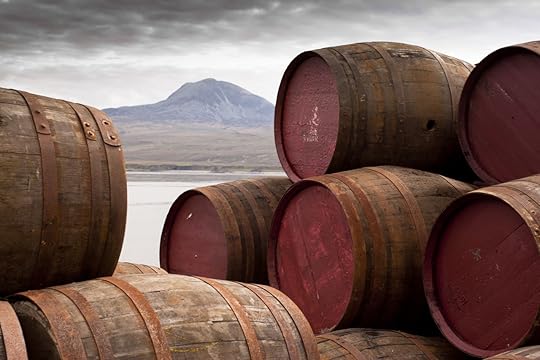
Whiskey is one of the world’s most beloved spirits. It’s both sipped neat and mixed into cocktails, savored and taken as a shot alongside a pint of beer. With this level of universal popularity, it should come as no surprise that countries around the world make the spirit. Each does things a little differently, making exploring the world through a dram or glass all too easy to do.
Quick note: America, Ireland, and Mexico use the spelling “whiskey.” Everywhere else goes with the English spelling of “whisky.” The letter “e” aside, these are the major differences between the world’s 10 best whiskey making countries.
1. United States

Photo: Maker’s Mark
There’s no single American whiskey category. There’s Tennessee whiskey, like Jack Daniel’s and Uncle Nearest, which is essentially bourbon that’s charcoal filtered. Then there’s a small but growing number of distilleries making American single malts made solely with malted barley or malted wheat. But the most popular styles in America are by far bourbon and rye.
Bourbon
To legally be called bourbon, it must be made with 51 percent corn and aged in new barrels.
“I think one of the biggest differences in tradition when making bourbon versus the whisky traditions from other places around the world is that bourbon, by law, requires that the liquid be stored in new oak barrels,” says Denny Potter, master distiller at Maker’s Mark. “This is part of the reason that bourbon is particularly expensive to produce — once we’ve used a barrel, we can’t use it again!”
After bourbon makers use the barrels, they’re often sold and shipped to other whiskey, wine, and beer producers. The barrels hold other liquid and impart a bit of bourbon flavor to everything they touch. “This ‘trading’ of barrels means that there is bourbon influence in your Scotch, just as there may be Scottish influence in your bourbon since many of the distilling traditions were first carried over to the States from Scotland,” Potter says.
It’s a common misconception that bourbon has to come from Kentucky, but it’s produced around the country. “Still, about 95 percent of bourbon does come from Kentucky, and we do tend to believe that the best bourbon is made here in the Bluegrass State,” Potter says.
Bottles to search for: Maker’s Mark ($30), Coopers’ Craft ($24), and Old Overholt ($17)
Rye
Rye must be made with 51 percent rye grains. This was the predominate whiskey in early America when more states in the Northeast grew rye, but it fell off in popularity. It’s seeing renewed interest thanks to bartenders. The taste is spicier and less sweet than bourbon, and it’s ideal for cocktails.
Bottles to search for: High West Double Rye ($35) and Knob Creek Rye ($38)
2. Scotland

Photo: Rebecca Schochenmaier/Shutterstock
Scotland’s signature spirit has a reputation as a serious drink. While that’s true in some cases, it’s much more diverse than that — something that’s evident if you ever get the chance to visit Scotland’s best distilleries. The major Scotch-producing regions are the Highlands, Speyside, the Lowlands, the Islands, and Islay. The latter get a lot of attention for big, peaty single malts like Lagavulin and Laphroaig. Other regions vary in peat levels, and some traditionally produce whisky with no peat characteristic at all (especially in Speyside, which is known more for sweet and fruity whisky).
Regardless of region, Scotch legally has to be aged in oak casks (most often old bourbon or old sherry casks) for at least three years in the country. Single malts made solely with malted barley are not the most common, despite the outsized attention they get. Blended Scotches that are a mix of barley and grain whiskies like Dewar’s, Chivas Regal, and The Famous Grouse are by far the best sellers in Scotch whisky.
Bottles to search for: GlenDronach 12 Year ($56) and Monkey Shoulder ($33)
3. Ireland
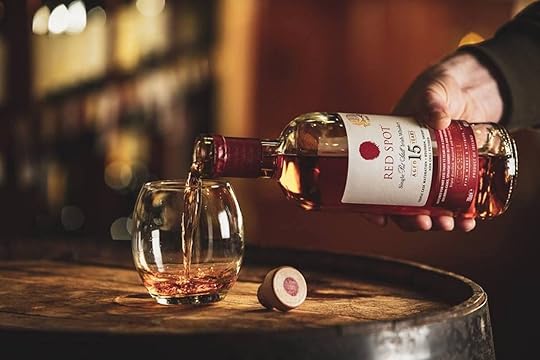
Photo: Spot Whiskeys/Facebook
Ireland is, by some accounts, the oldest whiskey producing country in the world. Today, it’s also one of the fastest growing, with new distilleries opening up every year. To qualify as Irish whiskey, it has to be made with malted or unmalted barley and aged in Ireland in oak barrels (often old bourbon barrels) for a minimum of three years. The taste is generally on the lighter side though there are Irish whiskeys out there with deeper chocolate and toffee notes.
If you know only one thing about Irish whiskey, it’s probably Jameson. The brand makes solid whiskeys and has a few experimental releases, but there are lots of notable Irish whiskeys out there besides Jameson if you really want to know the style. The best are made in a single pot still, and whiskey companies new and old are experimenting with different barrel aging techniques and single malting styles, so there’s always something new to try.
Bottles to search for: Green Spot ($57), Red Spot ($124), and Sexton ($30)
4. Japan

Photo: mTaira/Shutterstock
Japanese whisky is one of the trendiest options recently, leading to scarcity and high prices. Unlike many things in this world, however, the product matches the hype. Japanese whisky is most similar to Scotch in that there’s a range of light and fruity whiskies to heavily peated options. The earliest notable whisky producers in Japan also learned how to distill and age in Scotland. It started making waves in the whiskey world around 2014, when the Yamazaki Sherry Cask was named the whisky of the year in Jim Murray’s Whisky Bible. Today, two distillers, Nikka and Suntory, control the vast majority of whisky production in the country. The best way to taste Japanese whisky is to visit Japan’s best distilleries.
Japanese whisky lacks the strict legal definitions of bourbon and Scotch. Basically, it just has to be made in Japan to qualify. You’ll find whisky that’s aged in casks made from rare Mizunara oak alongside whiskies aged in ex-bourbon casks and ex-sherry casks. The main consistency from bottle to bottle is that Japanese whisky is consistently good (though you’re definitely going to pay for the quality).
Bottles to search for: Nikka From the Barrel ($63) and Suntory Toki ($40)
5. Canada
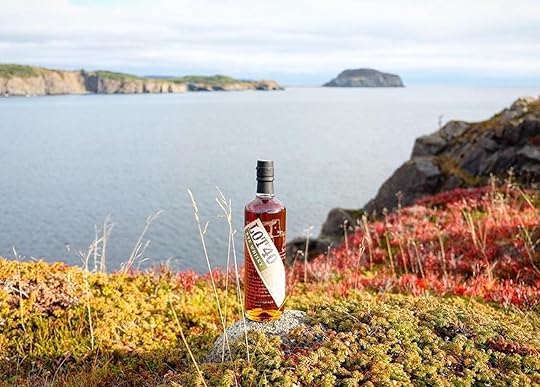
Photo: Lot No. 40/Facebook
Canadian whisky, like Irish whiskey, used to be extremely popular in the US. It dropped off during Prohibition, and it’s been misunderstood in the states ever since. For one, Canadian whisky is often considered to be only rye whisky. And while there are a good number of distilleries out in Canada using a fair amount of rye, there are also lots of distilleries using primarily corn like bourbon.
To legally be considered Canadian whisky, it must be distilled and aged for at least three years in the country. The more rye-focused whiskies will be spicy and fruity while those that primarily use corn and other grains have the sweet toffee and vanilla notes of bourbon.
Bottles to search for: Lot No. 40 ($40) and Pike Creek 10 Year Old ($31)
6. India
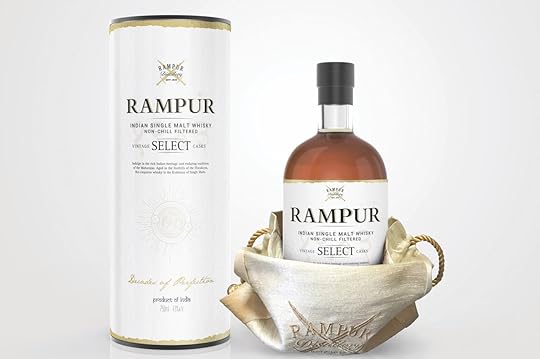
Photo: Rampur
“India is one of the biggest whisky consuming nations in the world,” says Sanjeev Banga, president of Radico Khaitan LTD., the company that makes Rampur Indian Single Malt Whisky. “Since India has a predominantly warmer climate, our whiskies tend to age faster than other countries, so much so that some say four times faster than Scotland!”
When it comes to volume, no one can compete with how much whiskey is consumed in India. Seven of the top 10 most-sold whiskeys are Indian brands, according to numbers from Forbes. Only, you’re not likely to see many of the brands in Europe or the US. Many of the top sellers are a mix of grain spirits and liquor distilled from sugar or molasses. A new crop of Indian whisky producers is looking to change that perception and show what the country is capable of, however, with all-grain single malts comparable to those produced in Scotland.
In terms of taste, Indian whisky varies widely. Some, like those put out by Paul John, are peaty, while others, like from Rampur, have spice and dark fruit notes.
Bottles to search for: Rampur Single Malt ($50) and Paul John Single Malt ($50)
7. France
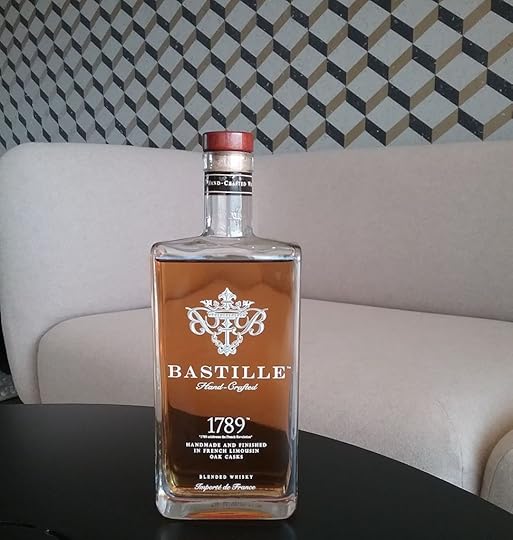
Photo: Bastille Whisky/Facebook
“While most often people only associate France with wine, we actually have some of the best ingredients, terroir, and technique to make a whisky that is French in conception, production, and taste,” Charles Daucourt, master distiller of Bastille 1789 Whisky, says. “French whiskies are characterized by notes replete of fruit-forward flavor, sweet spices, and leather.”
The French connection to wine is clear in some of the techniques that French distillers use. Bastille 1789, for example, uses the same type of stills as they do in Cognac and age the whiskey in barrels previously used for wine and Cognac. Another French brand, Brenne, also uses Cognac methods of distilling and aging. The result is a light and highly sippable whisky when drunk neat.
Bottles to search for: Bastille 1789 ($40) and Brenne Estate Cask ($60)
8. Taiwan
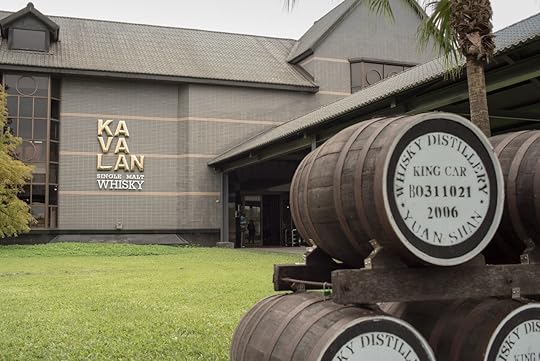
Photo: Colin Hui/Shutterstock
While far from the most talked about or most cherished whisky-producing country, Taiwan is home to Kavalan, which has beat out Scotches and American whiskeys to win hundreds of awards. It’s inspired by light Scotches, with a fruit-forward flavor profile. The thing that most sets it apart is the hot and tropical climate that the barrels are aged in, meaning a comparatively young whisky from Taiwan will have the same barrel influence as a Scotch whisky many years older. Like Japanese whisky, Taiwan doesn’t have strict classifications, so there’s also a lot of experimentation going on in the country.
Bottle to search for: Kavalan Classic Single Malt ($74)
9. Australia

Photo: Sullivans Cove Whisky/Facebook
The first distillery in the country opened in 1992, but Australia’s whiskey industry really got going in the early 2000s. Today there are a number of producers down under that are making award-winning whiskies, including Sullivans Cove’s 2014 win for World’s Best Single Malt — the only win for a distillery not in Scotland or Japan. The heart of Australian whisky is Tasmania where more than 30 distilleries are located. The best Tasmanian distilleries use Australian barley and local peat for a smoky flavor. While Australian whiskies are loved among whiskey nerds, they can be hard to get outside of Australia.
Bottles to search for: Sullivans Cove Double Cask ($180) and Starward Malt Whisky ($55)
10. Mexico
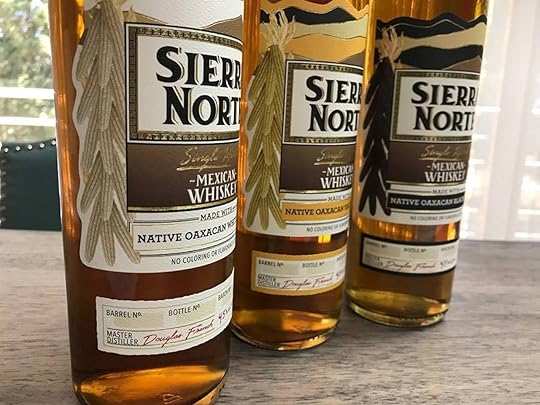
Photo: Sierra Norte Whiskey/Facebook
When you think Mexico and spirits, you probably think about tequila. Maybe you think about mezcal, or better yet, sustainable mezcal. Now, a new crop of distilleries wants you to think of whiskey. As of now, there’s really only one brand making highly drinkable Mexican whiskey: Sierra Norte. It’s made from different varieties of Oaxacan corn (85 percent of the whiskey) and malted barley (the remaining 15 percent) that’s then barrel aged. The bottle labels — white, yellow, and black — show the strain of corn used. White and Yellow are on the sweeter side while the Black is deeper with some fruit and pepper notes.
Bottles to search for: Sierra Norte White, Yellow, or Black ($50) 

More like this: The 5 most epic whisky experiences in Scotland
The post The major differences between the world’s 10 best whiskey-making countries appeared first on Matador Network.

Best US vintage trailer rentals
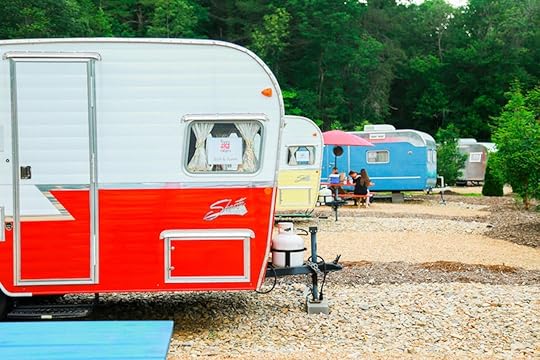
Before there was #vanlife, there was trailer life. In the 1950s and ‘60s, hitting the great highways and meandering backroads of the US with the family and a nicely outfitted trailer was the best way to see the country, and tons of great models emerged from that time period, including the now-iconic and coveted silver Airstreams. Nowadays, you’re more likely to see sleek modern RVs and boxy fold-out campers at campsites, but these charming relics of the USA’s great road-trip era are still floating around and finding new life as short-term rentals all over the country. So crank the jukebox and crack open a soda pop: These are the 10 most adorable vintage trailers that you can rent around the US.
1. The Vintages Trailer Resort, Oregon
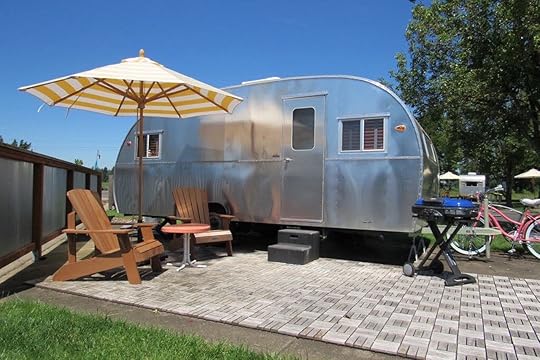
Photo: The Vintages Trailer Resort
The ambiance of this vintage trailer resort in the heart of Oregon wine country is so spot on that you’ll feel like you’ve gone back to the 1950s. Thirty-three vintage trailers of different makes and models — all immaculately restored and upgraded with modern amenities like hotel-quality linens, cozy beds, robes, and pour-over coffee — each have their own lot on the 14-acre Willamette Wine Country RV Park. Models range from sleek and shiny Airstreams to classic two-toned Shasta Airflytes, famous for their blaze of pastel (like red or turquoise) along the bottom of the trailer and “canned ham” design. Different trailers can accommodate between two and four people, and each comes with a private bathroom and outdoor area. Guests can use propane grills to make a barbecue, sit outside and enjoy the sunshine while sipping wine from the nearby vineyards, or go for a splash in the pool. Visit the website for rates.
2. Camp Leconte, Tennessee
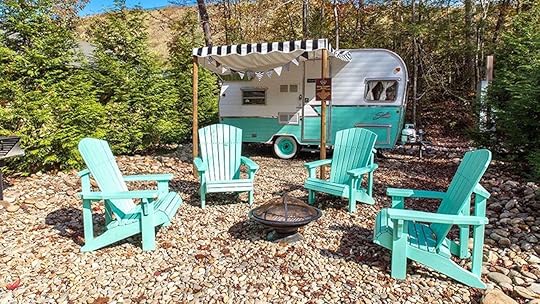
Photo: Camp LeConte
While these two 1961 Shasta Airflyte trailers at the luxury outdoor resort Camp Leconte in Gatlinburg, Tennessee, are technically described as replicas of the original, they’re just too cute not to want to stay in. The two models — named Glamping at Tiffany’s and The Ruby Slippers — have either red or turquoise color schemes, with cozy wood interiors and checkerboard floor. Each comes with a dinette that converts into a bed, a fridge, AC, a fire pit and charcoal grill, and are located close to the bathhouse. Perfect for glamping lovers or fans of the Breakfast at Tiffany’s and Wizard of Oz films. Visit the website for rates.
3. Hotel Luna Mystica, New Mexico
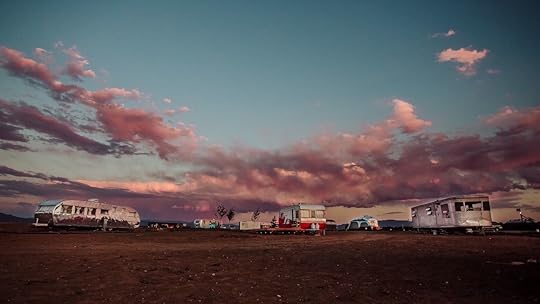
Photo: Hotel Luna Mystica
With its clear night skies, wide open spaces, and seclusion, the high plains of New Mexico have long been a popular spot for those wanting to commune with nature and live outside the status quo. In the small town of Taos, where living in alternative dwellings like Earthships is just par for the course, the Hotel Luna Mystica fits right in. Located out in the middle of the Taos Mesa — but just a short walk from a local craft brewery — the hotel’s 10 vintage trailers from the ‘50s and ‘60s have each been outfitted with features like outdoor decks, hammocks, and fire pits. Each has been restored to its original splendor, with hip interior decor and names that match their individual vibes. Each trailer is unique in its own way, but they all make you feel like packing up your whole life and moving to New Mexico to live under endless skies with no troubles. Depending on the trailer, prices start around $55 and up a night.
4. Kate’s Lazy Desert, California

Photo: Kate’s Lazy Desert
Have you ever wondered what the stars of those classic ‘60s and ‘70s bands do when not touring or writing music? Well, in the case of Kate Pierson of the B-52s, she opened an award-winning vintage trailer park. For lovers of that chill California vibe, Kate’s Lazy Desert resort is just the ticket. A short drive from Joshua Tree and Palm Springs, Lazy Desert has six different themed vintage airstreams, like the splashy and colorful hippie “Hairstream,” the fantastically kitschy “Tiki” Tiki bar-themed trailer, or “Lava,” colored on the insides with bright orange blobs of paint to give the impression of being inside a lava lamp! The concept for each Airstream comes from different artists, and in addition to their whimsical designs and decor, each one has a full bed, a bathroom, a small kitchenette, and endless desert and night sky views. Prices start at $175 a night.
5. The Cozy Peach, Arizona

Photo: Laura Reilly
Does it get cuter than a vintage trailer on an actual peach farm? At Schnepf Farms in Queen Creek, Arizona, a short drive from Phoenix, you can go glamping at The Cozy Peach — a small collection of renovated Airstream trailers brought to life by husband and wife duo Mark and Carrie Schnepf. The nine trailers — with one more on the way — each have their own aesthetic and include both sleeping and living spaces, a bathroom, modern amenities like WiFi and Netflix, and outdoor lawn space. For breakfast, you can choose between foraging for fresh fruit and veggies in their U-Pick garden; grabbing a slice of the butteriest, juiciest peach pie you’ve ever had at their bakery and country store; or simply order a home-cooked meal delivered directly to your trailer to enjoy in bed. Time your stay with early spring, and you’ll be able to enjoy stunning peach blossoms while you bike around the farm. Prices start at $145 a night.
6. Junebug Retro Resort, North Carolina

Photo: Junebug Retro Resort
Escape into the wilderness of North Carolina in vintage style at this charming retro resort near Asheville. Secluded in a quiet river valley, the 50-acre Junebug Retro Resort is a popular wedding and outdoor events venue, thanks in big part to its meticulous attention to detail in creating the illusion of 1950s paradise. The property is home to 10 different vintage trailers, including Spartanette Imperials and Royals, a Yellowstone 16’, a Trotwood, and an Anderson. But it’s the collection of Shasta Airflyte trailers that are the true gems: five cute-as-can-be Shastas in Butternut Yellow, Matador Red, or Seafoam Green, with checkerboard flooring and wood paneling on the inside. The different trailers sleep between two to five people and have amenities like a kitchen with fridge and gas stove, AC, linens, and access to fully equipped bathrooms. Pricing varies depends on event and season.
7. Sou’wester Lodge, Washington
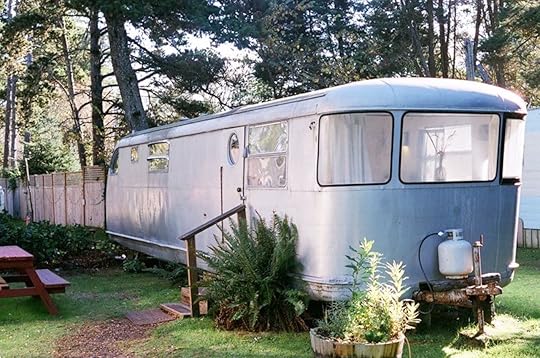
Photo: Sou’wester Lodge
Located on scenic Long Beach Bay in Seaview, Washington, the historic lodgings at Sou’wester have long been a popular Pacific Northwest wilderness retreat. While visitors can stay in a variety of accommodations from suites to cabins, their selection of restored vintage trailers is the main attraction. There are over 22 trailers to choose from, and they range in size from Rustic 16’ to spacious 40’ Deluxe; amenities vary depending on size, but all come with a kitchen or kitchenette, water, electricity, and heat (as well as access to a bathroom if one isn’t part of the trailer). Some of the most popular models include the Buena Vista, a 1947 Spartan outfitted in warm wood with red upholstery; the Old Spartan Park Model with its minimalist white interior; and the quaint and pastel-hued Estrellita. Visit the website for rates.
8. The Holidays, California
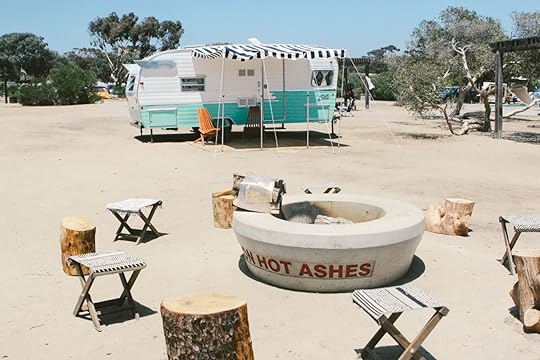
Photo: The Holidays
The Holidays is a camp community poised on a bluff over the ocean in beautiful San Clemente Beach, California. Three of the four vintage trailers — the Muir, the Drifter, and the Roadrunner — are classic Shastas, with that iconic colorful zig on the bottom of the body of the caravan, wood interiors, and checkerboard flooring. The trailers are ringed around an outdoor communal space, with a fire pit and picnic area. Each trailer can accommodate four people and comes with amenities like a kitchenette and AC. Prices start at $189 a night in the low season (November through March).
9. Camp G.R.I.T.S, Tennessee

Photo: Airbnb
This tiny Shasta, nestled in the woods of Cosby, Tennessee, is about as adorable as it gets when it comes to vintage trailers. The shiny red exterior is a dreamy contrast to the dark green and brown of the surrounding woods, making for a perfect Instagram pic. The interior is small but cozy, including a bed, dining area, and kitchenette. The stand-apart bathroom is another part of the charm, with the outhouse built of reclaimed popular and an outdoors claw-foot tub that can either provide a cool respite from the humid Smoky Mountains or heated with fire for a “hillbilly hot tub” during cool weather. Guests can also make campfires, and breakfast is provided every morning. Prices start at $70 a night on Airbnb.
10. Vintage Caravan, California
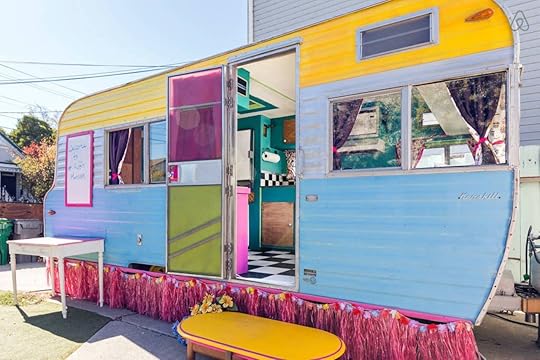
Photo: Airbnb
The pleasures of glamping in vintage trailers don’t exclusively have to be enjoyed out in the wilderness; you can find plenty of urban camping experiences in the some of the biggest cities in the US, like at this fabulously flashy trailer Airbnb in Oakland. The exterior of this vintage Kenskill is truly a glorious sight: painted in vibrant shades of baby blue, yellow, and its chrome has been polished to an absolute shine. On the inside, it only gets better: turquoise walls offset by wood cabinets, colorful bedding and decorations, and that classic black-and-white checkerboard floor. Housed in a green backyard with chickens, it can accommodate two guests and comes with a bathroom with shower, kitchenette, dining area, WiFi, and linens. Prices start at $75 a night. 

More like this: The cutest tiny houses to rent in the Pacific Northwest
The post The 10 most adorable vintage trailers to rent around the US appeared first on Matador Network.

US no longer needs visa for Brazil

For a few years now, Brazil has been experimenting with its visa program when it comes to travelers from the US. In 2016, the country temporarily waived visa requirements to attract US citizens for the Summer Olympics, and in 2018, it launched an e-visa program to make visa acquisition easier for US travelers. Now, the country is eliminating the visa requirement altogether, making it easier than ever for Americans to travel to Brazil.
Starting on June 17, American, Canadian, Australian, and Japanese travelers will be able to stay for up to 90 days in Brazil without a visa. The new regulations are an attempt by the country’s new president, Jair Bolsonaro, to boost Brazil’s tourism industry and improve relations with the US. Currently, Brazil sees around 6.6 million annual visitors but hopes to more than double that to 12 million by 2022.
In a press release, Visit Brazil said, “Now, with a strong Dollar and dozens of daily flights, experiencing Brazil is just a matter of desire and grabbing a plane. From the Amazon in the North, to the wines in the South; from the exotic Pantanal in the Midwest to the lush beaches of the Northeast; amazing cities like Rio de Janeiro, São Paulo, Salvador and hundreds of hidden gems are just a few hours away.” The country’s Tourism Minister Marcelo Alvaro Antonio added, “This is one of the most important achievements of the Brazilian tourism industry in the last 15 years and we are confident that it will be extremely beneficial to the country.” 
H/T: Condé Nast Traveler

More like this: How to experience the best of Japanese culture in São Paulo
The post US citizens will no longer need a visa to visit Brazil appeared first on Matador Network.

Former churches turned into bars
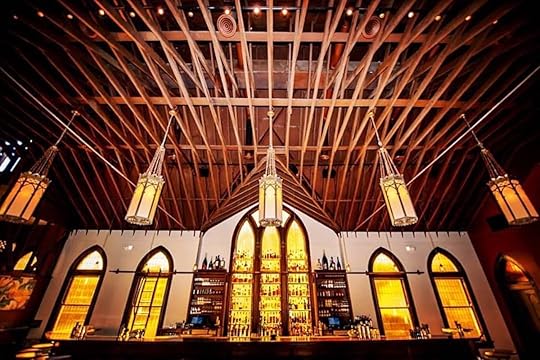
Historic churches are already some of the most gorgeous structures in the world. Recently, a select few have been turned into something even more beautiful — bars. Don’t worry, it’s not sacrilegious. These churches have been deconsecrated, so they’re simply regular buildings with stunning architectural designs at this point.
The conversion is a win-win for both the churches and the bars. Official estimates list the number of church closures at around 4,000 a year, and new tenets are keeping the walls up and the doors open. Plus, conscientious drinking has long been a part of organized religion, and doing so in a beautiful location is all the better for the bar and the bargoers.
No matter what day of the week, it’s time to get to a (former) church. From Denver to Dublin, these are the most gorgeous places in the world where you can grab a beer and/or a cocktail in an old church.
1. The Church Brew Works, Pittsburgh, Pennsylvania
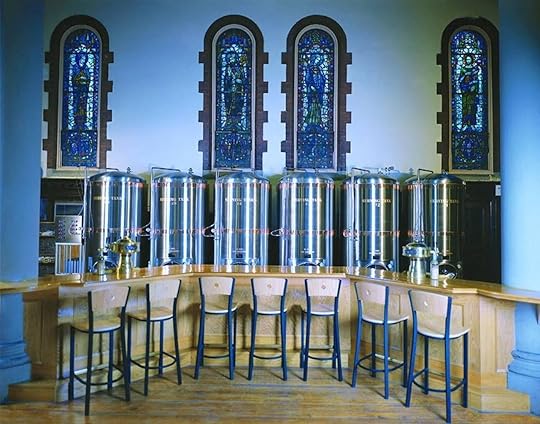
Photo: The Church Brew Works/Facebook
Vaulted ceilings, high arches, and stained glass are what to expect when stepping into this former Roman Catholic church in Pittsburgh’s Lawrenceville neighborhood. The building was originally constructed in 1902 and opened as The Church Brew Works in 1996 after extensive renovations. Inside, you’ll find a variety of brews — many of which are award winners — with cleverly themed names like Pipe Organ Pale Ale and Pious Monk Dunkel. The Church Brew Works is open for lunch and dinner and serves dishes like pierogies, ribs, and chicken and sausage jambalaya.
2. Taft’s Ale House, Cincinnati, Ohio

Photo: Taft’s Brewing Company/Facebook
Taft’s Ale House, which used to be known as St. Paul’s Evangelical Church, was once the oldest Protestant parish in Cincinnati. The church itself is a more modern structure with lots of wood and brick and a medieval-style chandelier in the center of the room, but it’s nonetheless a gorgeous place to enjoy a cold brew. Taft’s signature beer menu has a little bit of something for everyone, whether you want to go deep and dark with the Maverick Chocolate Porter or you have a hankering for Nellie’s Keylime Caribbean pale wheat ale. Bring your appetite for delicious dishes like beer-brined smoked wings, steak tacos, and a hickory smoked pulled-pork sandwich.
3. The Church, Dublin, Ireland

Photo: The Church Café, Late Bar & Restaurant/Facebook
St. Mary’s Church of Ireland was built in Dublin at the beginning of the 18th century, and when it closed its doors in 1964, it left behind stunning features like a Renatus Harris-built organ and stained-glass windows. It lay neglected for a number of years before it reopened as The Church in 2005. Now, it serves as a cafe, bar, restaurant, and nightclub with a large oval bar and two tiers of balconies overlooking the main floor. You can choose to drink in the large main bar, dance in the clubby Cellar, or host a private event in the intimate Tower room.
4. Vessel, New Orleans, Louisiana
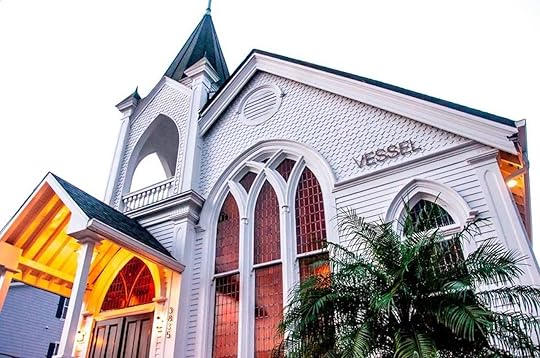
Photo: Vessel NOLA/Facebook
This stunning space houses one of the most beautiful bars in New Orleans. Vessel’s home is a 1914 church located in Mid-City that features a dramatic beamed ceiling, floor-to-ceiling windows, and a large outdoor patio for al fresco drinking. The cocktail menu is diverse and offers a number of classic drinks as well as signature creations, like the Tigers Pacing in a Cage, which is made with bonded rye whiskey, China-China, maraschino, pineapple, and lemon. Go for happy hour when classic cocktails are $6 and snack on small plates like crispy pork belly, and smoked Gulf fish dip.
5. Pitcher & Piano, Nottingham, England
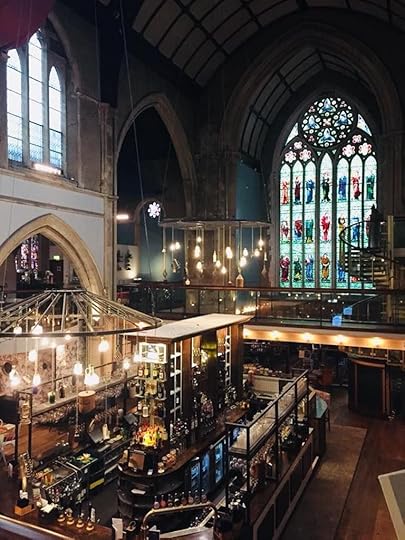
Photo: Pitcher & Piano Nottingham/Facebook
Pitcher & Piano has 18 locations throughout the UK, but the Nottingham venue is by far the most stunning. It’s housed in the former High Pavement Chapel, which served as a Unitarian place of worship from 1876 to 1982. Many of the original details have been preserved, so you can sit at the beautiful oval bar and admire the large stained-glass windows and stone arches. The drink menu at Pitcher & Piano is huge and features everything from classic cocktails to wine and beer. There’s even a menu dedicated to gin and tonics. Globally inspired food feeds hungry drinkers with dishes like chicken pakoras and a cajun buttermilk chicken sandwich.
6. The Church Nightclub, Denver, Colorado
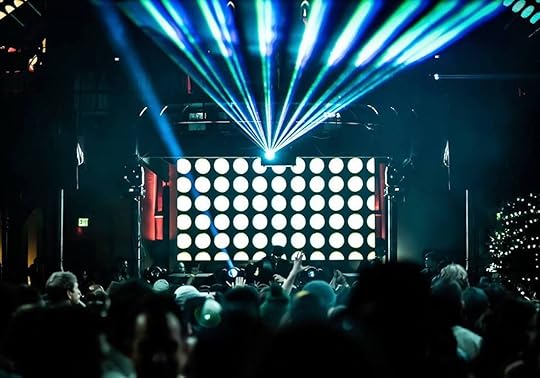
Photo: The Church Nightclub/Facebook
If you’re into the club scene, then this just might be the most beautiful place to get your dance on in the US. The former Episcopal church was completed in 1889 and served the Denver community for 86 years. The Church Nightclub opened in 1996, and original details like high-beamed Gothic architecture and stained-glass windows are joined by state-of-the-art lighting and a Void Acoustics Incubus Sound system. The Church offers music for everyone, whether you’re into house, Latin, industrial, or dark indie and techno. You can grab your usual vodka sodas at the bar or opt to spend big with a VIP table and bottle service. 

More like this: 7 of the world’s coolest-looking churches you didn’t know existed
The post 6 gorgeous churches that have been turned into breweries and bars appeared first on Matador Network.

Win a house in Italy for just $66
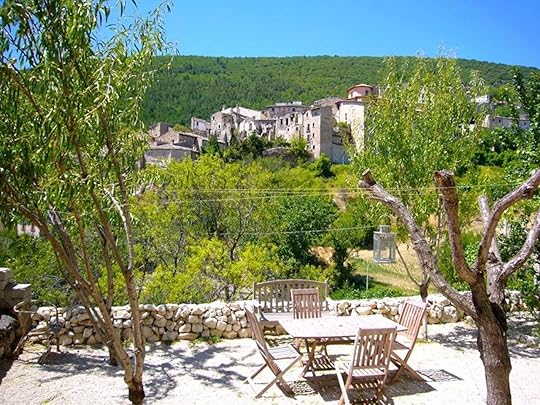
After failing to sell his home in the town of Carapelle Calvisio, Italy, this British man has decided to get creative. Jamie Abbott wrote online that he “tried to sell the house via the usual means, using knowledgeable local and international agents, but the market has been quiet.” That’s why he’s decided to run a competition so one lucky winner will get the keys to his villa in Italy.
The three-story house, valued at $282,000, is being raffled off to one lucky bidder. Abbott has created 6,000 raffle tickets and is selling them for $66 each, with the randomly selected winner receiving the keys to his house for free (well, for $66).

Photo: Win A House In Italy/Facebook
The restored stone house located on the edge of Abruzzo’s Gran Sasso National Park has three bedrooms, an original stone staircase, a fireplace, a bathroom with a cave ceiling, a lovely terrace, and a garden with fruit trees and grapevines. Not too shabby for $66.
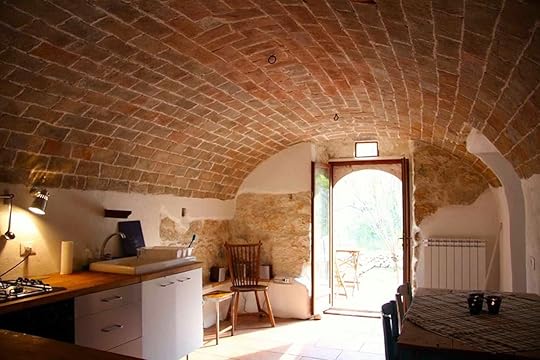
Photo: Win A House In Italy/Facebook
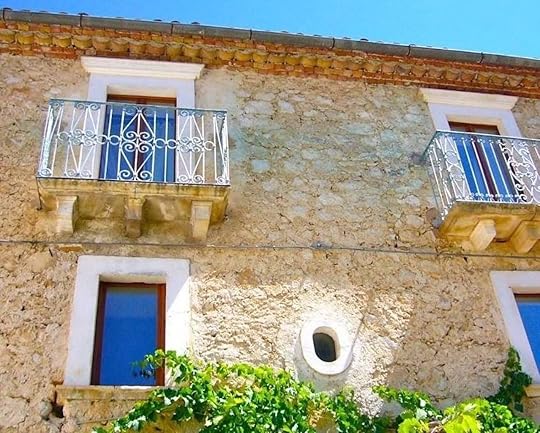
Photo: Win A House In Italy/Facebook
Even if you fall just short of the top prize, a second-place winner will win $13,270, and five third-prize winners will receive a hamper filled with local food and wine. The contest is open until September 30, or until the 6,000 raffle tickets sell out. It looks like tickets are going pretty fast, so if you want a chance to win, you’ll have to move quickly. To enter or to obtain more details about the property, visit the official contest website. 
H/T: Insider

More like this: Padua is the answer to an overcrowded Venice
The post You can win a villa in Italy for just $66 appeared first on Matador Network.

Most bizarre theme parks in world
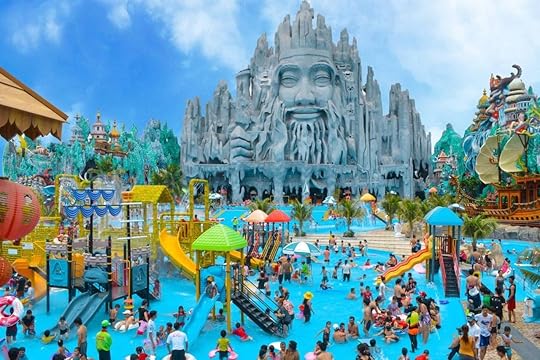
If you want a traditional and predictable family vacation, head to Disney World, ride the teacups, and leave with a few mouse-ear hats. However, if you want an experience that isn’t all princesses and cartoon animals, there are plenty of bizarre amusement parks out there to satisfy your craving. From the explicit Loveland in South Korea to Lithuania’s Išgyvenimo Drama, a Soviet-themed park that gives visitors a brutal taste of life in the former USSR, these seven parks might not be the happiest place on earth, but they will certainly make a lasting impression on anyone who visits.
1. Haw Par Villa, Singapore
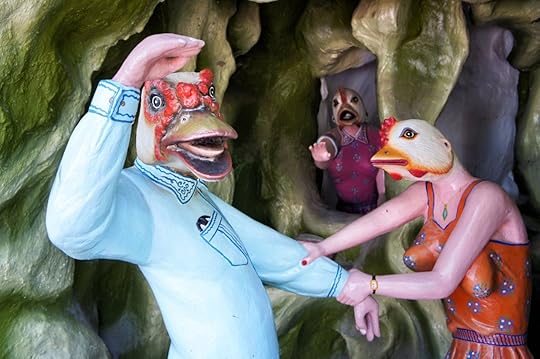
Photo: Haw Par Villa
Haw Par Villa is technically a theme park, but it’s more like a graphic lesson in morality. This park located Singapore was built in 1937 and is filled with statues and dioramas representative of Asian culture, history, philosophy, and religion meant to give visitors an idea of what a virtuous life should look like. The park is especially famous for its Ten Courts of Hell diorama, a brutal depiction of what supposedly happens to those who stray off the good path. Basically the Chinese folklore version of the Last Judgement and subsequent hell, this diorama shows the after-life punishments for various moral and criminal offenses, like corruption and disrespecting your elders. As you wander through, you will encounter a tax evader being crushed by a pointy stone hammer, and a student being disemboweled by an executioner for cheating on a test — not exactly kid-friendly by today’s standards.
The park is open every day from 9:00 AM to 7:00 PM, and admission is free.
2. Išgyvenimo Drama, Lithuania

Photo: Sovietinis bunkeris/Facebook
Located in Lithuania, Išgyvenimo Drama, or “Survival Drama,” is designed to give visitors the authentic experience of living in a Soviet bunker in the middle of the Lithuanian forest in 1984. Guests are gathered in a genuine bunker, deprived of their personal belongings, made to listen to the Soviet anthem and be barked at, interrogated KGB-style, humiliated, and given a taste of Soviet medicine. The whole experience lasts about three hours, and to participate you must sign a waiver, since disobedience may result in physical or psychological punishment. Needless to say, it’s probably not a great idea to take the kiddos.
The bunker is located 17 miles from the capital city of Vilnius. The exact location can be found on Google Maps. To learn more about the Soviet bunker, check out the official website of the park.
3. Loveland, South Korea
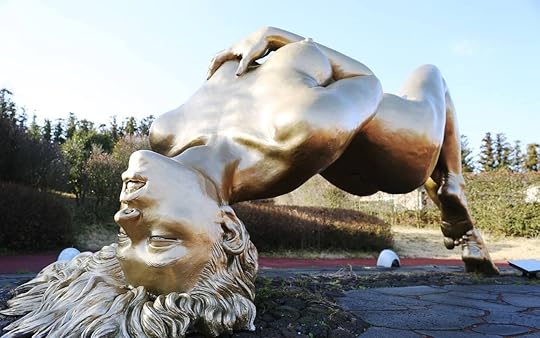
Photo: 제주러브랜드/Facebook
Add Loveland to the list of theme parks that aren’t exactly suitable for children. Located on the island of Jeju in South Korea, Loveland is an erotic sculpture park featuring pieces depicting various sexual acts. According to the website, the park provides a “proper approach to sex culture and it is decorated with a lot of beautiful artworks.” Loveland also has indoor exhibits displaying wooden sculptures of penises, a collection of adult toys, and imaginative art works of sexuality. The park is open year-round, from 9:00 AM to midnight, and adult entry costs about $11 per person.
4. Parque Jaime Duque, Colombia

Photo: Parque Jaime Duque/Facebook
Parque Jaime Duque, one hour outside of Bogota, Colombia, is an odd mix. It’s a theme park with replicas of famous monuments such as the Taj Mahal and the Seven Wonders of the Ancient World; huge sculptures of aircrafts and dinosaurs; decommissioned military ships; a colorful medieval castle; mechanical attractions like a monorail train, bumper cars, and a carousel; a biopark with birds, deer, and primates; and the like. The park is family friendly and, despite featuring a strange assortment of attractions, is educational and a ton of fun for kids. Admission is $34.
5. BonBon-Land, Denmark
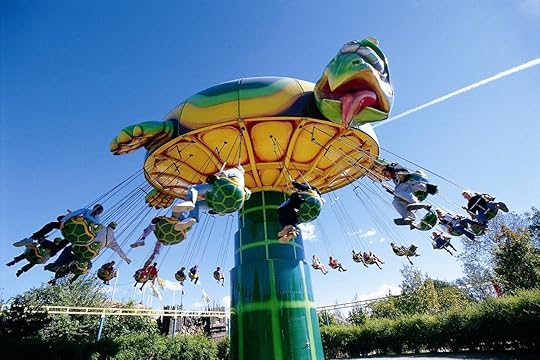
Photo: BonBon-Land/Facebook
This place might the closest thing to a real-life, upside-down Willy Wonka’s Chocolate Factory. Located in Holmegaard, Denmark, about 50 miles southwest of Copenhagen, BonBon-Land is a confection-filled dream for kids and very immature adults. The owners of a candy factory decided to open a theme park in 1992 with rides featuring the same wackily named chocolate treats. Seagull droppings, ear wax, and dog farts are among the juvenile sweet treats you’ll find in BonBon-Land, in addition to dozens of rides such as “Dog Fart Rollercoaster” and “The Water Rat.” Imagery around the park is consistently crass, with depictions of vomiting rodents and urinating ants. If you just heard “urinating ants” and thought “sign me up!” then admission costs $23 per person. The park reopens for the season on April 27.
6. Suoi Tien Park, Vietnam

Photo: Suoi Tien Theme Park/Facebook
Suoi Tien Park is a huge theme park 40 minutes away from Ho Chi Minh, Vietnam, with an unusual aesthetic. Although there are the run-of-the-mill theme parks attractions such as water slides, roller coasters, waterfalls, and a ferris wheel, the park is decorated with Vietnamese history and folklore, as well as with Buddhism in mind. There are dragons, Buddha statues, temples, a wishing tree, and arches, but there are also seemingly out-of-place medieval castles and sculptures. One of the park’s most striking (or startling) features is a crocodile farm with about 1,500 crocodiles, which you can actually feed. Park prices can be found on the official website.
7. Weeki Wachee Springs State Park, Florida, USA

Photo: Weeki Wachee Springs/Facebook
The Weeki Wachee Springs State Park in Florida is a spot made for those whose childhood dreams were to be Ariel and live under the sea. There are mermaid shows, including performances of Hans Christian Andersen’s The Little Mermaid, as well as river boat cruises, lazy river floats, kayak and paddleboard rentals, a sandy beach, waterslides, and wildlife shows to fill your days. The mermaids are trained performers who thrill audiences with tricks like eating and drinking underwater. Tickets cost $13 per person from April 18 to November 5, and $8 per person during the rest of the year. 

More like this: Every roller coaster at Cedar Point, ranked
The post The 7 strangest theme parks around the world appeared first on Matador Network.

March 18, 2019
The best coffee in Panama

Coffee is something most of us take for granted. It shows up in our cups every morning, whether we take the time to grind our own beans or simply order the usual from a local cafe. But when you see the effort and care that goes into growing, harvesting, drying, and roasting coffee, it opens your eyes to how precious a simple cup actually is. Making a pilgrimage to the source during harvest will deepen your respect for the drink that gets you up every morning, and there’s no better place to see the process first hand than Panama.
Compared to other countries, Panama’s coffee production is small but mighty. The country’s output is billions of pounds less than places like Brazil and Colombia, yet many of the estates are still owned by families who do things the right way. They hand-pick the coffee cherries and care about the ecosystem, making strides to protect the environment around them. Panama is also home to the Geisha bean, which is one of the best and most expensive in the world. The combination of family farms and world-class coffee beans is more than enough to earn a spot on any coffee lover’s travel wish list. Here’s every place you need to visit to get your caffeine fix, along with the best places to stay and eat along the way.
Start your journey in Panama City.

Photo: Gualberto Becerra/Shutterstock
Although the best coffee farms to visit are in the Chiriquí Province, your trip will likely start in Panama City when you fly into the country. Take an extra day or so to enjoy this vibrant metropolis, which has a number of excellent restaurants, coffee shops, and hotels to enjoy.
Where to stay: You’ll find chic and comfortable accommodations at an affordable price at The Bristol. If you have the budget, spring for a tower executive room, which comes complete with a big shower and grand soaking tub. An outdoor pool and spa are there for when you need to relax before or after your adventures, and there’s a quick on-site restaurant, Salsipuedes, for breakfast before heading out.
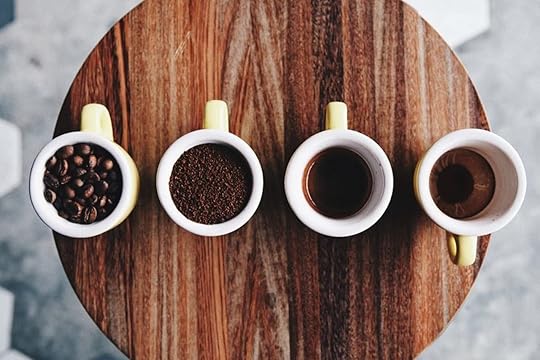
Photo: Leto, Coffee Brew Bar/Facebook
Where to get a cup of coffee: There are, naturally, excellent coffee shops in Panama City where you can get your first taste of Panamanian beans. Mentiritas Blancas serves expertly made Geisha coffee pour-overs and some of the best baked goods in the city. Leto, situated in Panama City’s bustling San Francisco neighborhood, is the place to go for pour-overs and coffees made with an Aeropress, Chemex, and siphon, as well as for drinks like cappuccinos and matcha lattes.
Where to eat: There’s no shortage of excellent restaurants in Panama City, so come with a hearty appetite. Maito is a must-visit and was recognized as one of Latin America’s best restaurants by World’s 50 Best Restaurants. Here, chef Mario Castrellón experiments with classic Panamanian flavors and local ingredients to create a diverse menu of modern plates — think coconut octopus wontons and black rice with chorizo and conch.
Getting to the coffee farms in Chiriquí Province
The drive from Panama City to Chiriquí is about eight hours. A much easier way to get there is to take a 40-minute flight from Albrook Airport in Panama City, which is a hub for regional travel, and land in Enrique Malek International Airport in the city of David, the capital of Chiriquí. From there, you’ll need to rent a car to drive to Boquete and Volcán to visit the coffee estates.
Your coffee experience in Boquete
Start your journey in Boquete, which is a little more built up than Volcán, to get acquainted with the region. There are a few wonderful coffee farms to visit, but make appointments because most of them don’t take walk-ins.

Photo: Amanda Gabriele
Coffee estates to visit: First, stop at Elida Estate, which has been owned by the Lamastus family since 1918. The 65-hectare farm grows Geisha, Arabica, and Catuai coffee varieties and is located in the Volcan Baru National Park, a protected ecological reserve. Booking the Tour “La Torre” to explore the high elevations of Elida Estate by car and take in sweeping views of the plantation. On the way back to the mill, you’ll get a cup of Geisha coffee in the beautiful, modern shop. Next, pay a visit to Finca Dos Jefes, a seven-acre farm that produces Cafés de la Luna coffee. Here, beans are organically grown in conjunction with the moon phases before being naturally processed and roasted on site. Finca Dos Jefes’ immersive tour starts with a walking tour of the farm, moves to coffee tasting, and concludes with a hands-on roasting experience.
Where to eat: Boquete has a sizable expat community, and the food is just as diverse as the people. One great example of this is Colibrí, a restaurant serving globally inspired cuisine from a Colombian and Italian who fell in love with Panama during their travels. The menu has everything from shrimp ceviche marinated in passionfruit to a lamb burger with local goat cheese. Don’t miss the Geisha coffee tiramisu for dessert. Seafood lovers should pay a visit to Boquete Fish House Restaurant, which is situated on a little river. The sea bass, fish and chips, and prawns are all winners here, but your best bet is to order off the board of daily specials.
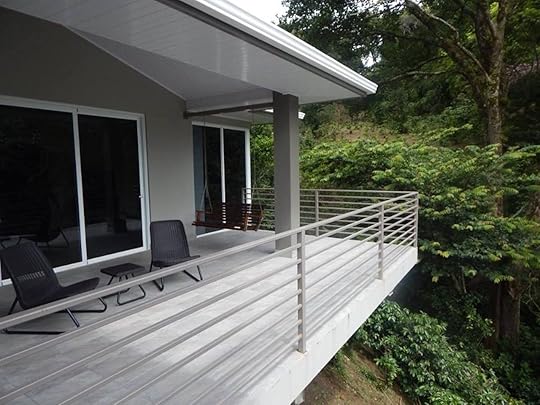
Photo: Coffee Estate Inn/Facebook
Where to stay: When it comes time to rest your head, there are an ample amount of comfortable options in Boquete. At La Montaña y El Valle Coffee Estate Inn, not only will you experience spacious rooms with heated floors and expansive decks with views of the Baru Volcano, but you can also participate in the roasting process of the hotel’s own estate-grown coffee. Finca Lerida is another gorgeous Boquete hotel with rooms that have luxurious bathrooms, in-room espresso machines, fireplaces, and terraces complete with hammocks. Guests can enjoy coffee tours of the hotel’s plantation, bird watching, and hiking through the expansive grounds. Don’t miss a meal at hotel restaurant La Brulerie, which makes homemade bread, pasta, soups, and jams from fruit grown on site.
Your coffee experience in Volcán
The town of Volcán, which is located in Chiriquí’s Tierras Altas district, is about a two-hour drive from Boquete. Volcán is across the Baru Volcano from Boquete, and you have to drive around it to get there. Just like in Boquete, it’s best to make advance appointments for any coffee estates you want to visit.
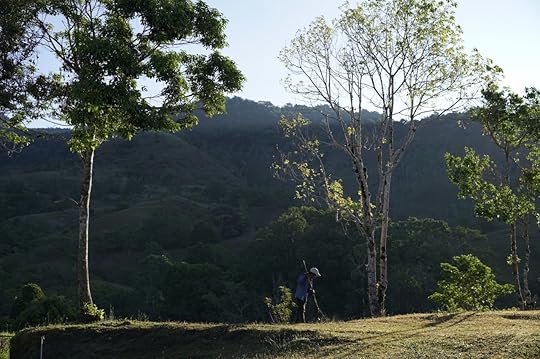
Photo: La Cosecha
Coffee estates to visit: First, stop at the sprawling Ninety Plus Coffee Farm, a 450-acre estate run by founder Joseph Brodsky. His whole philosophy stems around “leaving coffee better than he found it” by committing to canopy and restoration ecology. The bumpy ride through the farm’s mountainous terrain is worth it for the relaxed coffee tasting on a patio overlooking Ninety Plus’s grounds.

Photo: La Cosecha
Carmen Estate Coffee is also a must-visit when in Volcán. The brand has been producing high-quality Arabica coffee for more than 50 years, and visitors can see how the coffee cherries are harvested, watch a roasting demo, and see how the beans are packed for shipping. Janson Coffee Farm is an especially fun place to visit in Volcán. Not only can you tour the coffee estate, but Lagunas Adventures has also partnered with Janson to offer activities like horseback riding, kayaking, fishing, and birding. If you’d like to continue on your nature journey, pay a visit to Haras Cerro Punta. This gorgeous estate has been breeding thoroughbred racehorses for generations, and it’s worth it to take a tour for the scenery alone. There, you can also sample a cup of Eleta Coffee, which is grown by the same family on their farm near the border of Costa Rica.
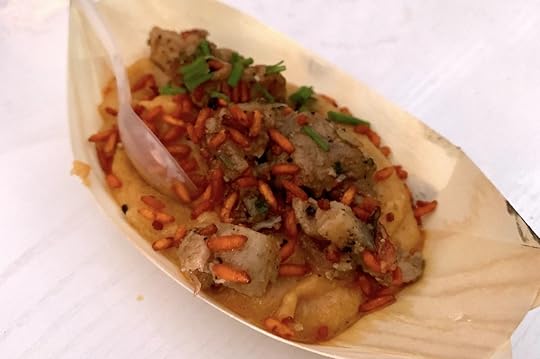
Photo: Amanda Gabriele
Where to eat: Cerro Brujo Gourmet is one of the best places to dine in Panama. Chef Patricia Miranda infuses Panamanian cuisine with worldly flavors and uses herbs and vegetables grown in her own garden. For lunch, we feasted on eggplant filled with boda (a palm flower that is similar in look and taste to baby corn), a fresh green salad with daikon and strawberries, mashed malanga (a root vegetable similar to taro), and seven-hour roasted pork. Call ahead because Cerro Brujo doesn’t always keep normal hours. If you’re looking for a quick, casual meal, visit Aqui Va La Niña. This covered outdoor restaurant is basically a food truck that serves mouthwatering burgers, wings, ceviche, and tamal de olla, a Panamanian-style tamale. If you’re lucky, a local band will be playing some live music while you dine.
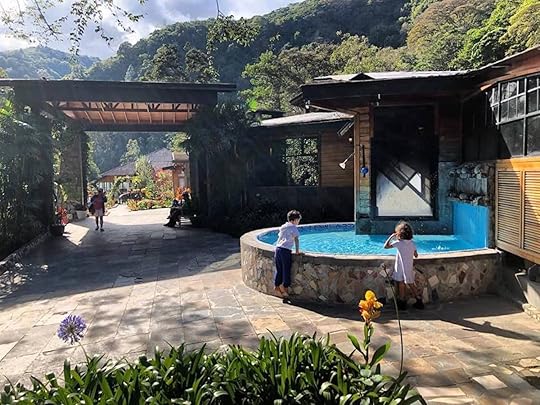
Photo: Casa Grande Bambito/Facebook
Where to stay: There’s nowhere to stay in Vulcán that’s more beautiful than Casa Grande Bambito. The mountain hotel is filled with tropical flowers and lush vegetation, and birdsong can be heard throughout the morning and afternoon. The rooms are rustic but comfortable and feature separate sitting areas and private bathrooms. There is a pool, game area, and restaurant on site so you can grab breakfast before heading out for a day of coffee exploration. 

More like this: The 5 most epic coffee experiences around the world
The post How to take the ultimate coffee trip through Panama appeared first on Matador Network.

Game of Thrones filming locations
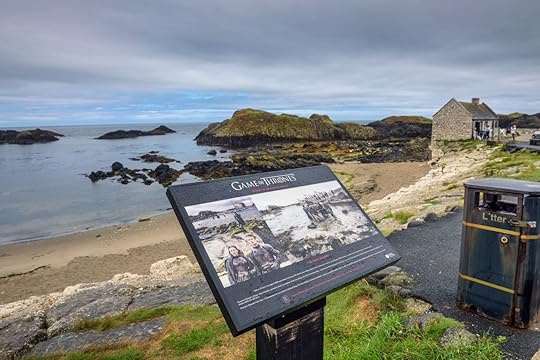
With only a month left until the final season, the end of Game of Thrones is just around the corner. We’ll finally get answers to questions that have plagued us for years on end, like is Bran the Night King? Who is Azor Ahai? Will the White Walkers be defeated? And perhaps most importantly, who will end up on the Iron Throne — if anyone at all? While we still can’t see the soundstage sets from Titanic Studios in Belfast or Castle Black, you can see plenty of filming locations throughout Northern Ireland in a single day trip.
Most tours operate out of Belfast and will usually play scenes where the location you’re traveling to appears, give some history, and sometimes even provide costumes for dressing up. While some may consider these cheesy, they’re all in good fun, and you’ll have a memorable experience with a lot of laughs. But they can be expensive, and your schedule will be dictated by the guide. Thankfully, it’s easy to drive to these locations yourself for free (assuming you’re cool with driving on the other side of the road). Here’s everything you can see on a one-day Thrones-themed road trip — including some non-GoT sites you shouldn’t pass up seeing along the way.
Warning: Spoilers ahead, but if you’re not caught up by now, that’s kind of on you.
Cushendun Caves
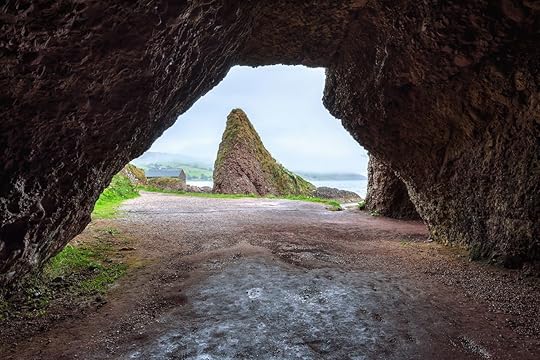
Photo: Nick Fox/Shutterstock
Cushendun Caves and the surrounding area were important early on in the show, being used for the Stormlands that served as House Baratheon’s stomping grounds. The shape of the caves is due to hundreds of millions of years’ worth of extreme weather, especially being right on the water. The caves themselves were only used once, but the effects of the scene that took place there can still be felt in later seasons. After a futile parley in which Stannis failed to get his brother Renly to accept him as the true king, he ordered Davos to take Melisandre to a cave near Renly’s camp, where she then gave birth to a shadow creature that killed Renly. The beach is pretty scenic to walk around, shadow babies or not.
The Dark Hedges
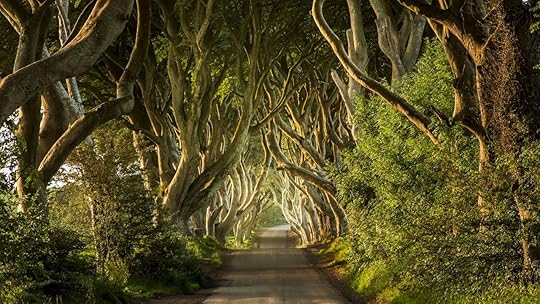
Photo: Michael Rocktaeschel/Shutterstock
From Cushendun Caves, it only takes around half an hour by car to get to one of the most iconic sights for both Game of Thrones and Northern Ireland. The Dark Hedges are an avenue of beech trees that were initially created to amaze visitors on their way to the Gracehill House, a Georgian mansion. In GoT, they’re used as the Kingsroad, the equivalent of a highway in Westeros, running from Castle Black in the North down to King’s Landing in the South. In particular, it’s used in the show when Arya, disguised as a boy, has escaped from King’s Landing in the second season and is traveling with a group of men bound for the Night’s Watch, among other scenes.
Carrick-a-Rede rope bridge

Photo: Nahlik/Shutterstock
While not directly a GoT location, the Carrick-a-Rede rope bridge inspired the bridge Balon Greyjoy was pushed over by Euron Greyjoy — and looks just like it. Head up to the coast from the Dark Hedges and you’ll arrive at your destination in around 20 minutes. The bridge was built in 1755 by fishermen who thought Carrick-a-Rede was a perfect fishing spot, however, fishing there is not as common in recent years. It’s 30 meters (98 feet) above the ocean and 20 meters (67 feet) long, and it also undergoes frequent restoration of sorts to make sure it’s safe for crossing. The bridge does sway a fair bit, though, so it’s not for the easily frightened — but if you’re Ironborn, you should have no problem. Crossing it costs £9 for adults and £4.50 for children, and it’s worth every penny; the views of Rathlin Island and Scotland in the distance are spectacular.
Ballintoy Harbour
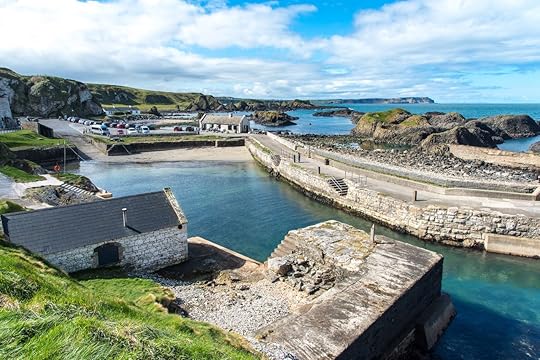
Photo: Paul J Martin/Shutterstock
Speaking of the Ironborn, just under 10 minutes away from Carrick-a-Rede is Ballintoy Harbor, which was used for several scenes in the Iron Islands, home to the Greyjoys. The harbor itself was used as a port in Pyke where Theon gets a boat to sail back home. Just a few feet away is the beach, which was used for Theon’s baptism into the religion of the Drowned God and then the Kingsmoot in season six, where Euron and Yara vied for the Salt Throne.
Giant’s Causeway

Photo: SF/Shutterstock
Drive along the Causeway Coastal Route for 20 minutes and you’ll reach the scenic drive’s namesake. Giant’s Causeway isn’t a filming location, but it’s included on almost every GoT tour because to skip seeing this world wonder would be very, very foolish. This UNESCO World Heritage site is a series of over 40,000 natural hexagonal pillars, with a history that goes back nearly 60 million years. Its fantastical design has inspired some origin tales; the most popular theory to date is that Fionn mac Cumhaill, an Irish giant, got into a fight with a Scottish giant named Benandonner. The two were known to hate each other and frequently insulted one another. One day Fionn got so fed up that he built a path to Scotland, and Benandonner destroyed most of it — what remains is the Giant’s Causeway. It probably would have made for an epic Dragonstone set if it weren’t so recognizable. Prices are £12.50 for adults, £6.75 for children, and free for those under age five.
Dunluce Castle
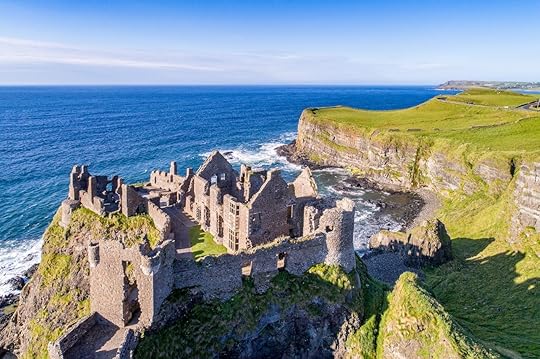
Photo: Nahlik/Shutterstock
Following along the Causeway Coastal route lends to gorgeous scenery and a number of other Game of Thrones sites. Dunluce Castle is another such example, serving as Castle Greyjoy. The castle was built in the early 1500s by the MacQuillan family, seized by the MacDonald clan in 1550, and home to earls in the 1600s. Legend has it that during a stormy night in 1639, part of the kitchen fell into the sea, and only a kitchen boy survived. Some visitors even claim they see ghosts, particularly that of the Banshee of Dunluce Castle, who’s believed to be the daughter of Lord MacQuillan. It’s a quick stop, but at 10 minutes away from Giant’s Causeway, it doesn’t hurt to stop by. It’s £5 for adults, £3 for children and seniors, and free for kids under five.
Castle Ward
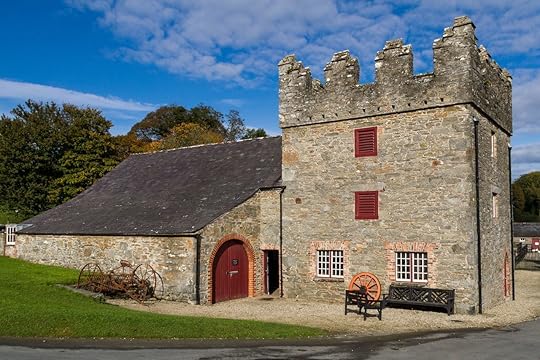
Photo: Paul Krugman/Shutterstock
If time allows, there are a few other locations you should visit on your trip. Two hours south in the opposite direction, past Belfast, you’ll find Castle Ward. HBO used this 18th-century estate as the location for Winterfell scenes for the pilot episode. It’s important to note that the estate doesn’t look much like the current Winterfell since CGI was used to generate most of the buildings, but you will notice a resemblance. One of the taller buildings in particular, with a single window at the top and a red wooden door, that’s easily identifiable in the pilot. Other than that, Castle Ward offers a number of activities to get you in the GoT spirit. In the pilot, Jon, Robb, and Bran are using an archery range, and Castle Ward has replicated the range in the exact same spot, allowing visitors to try their hand at archery. As an added bonus, you can even dress up in similar clothing. Entry is £8.18 for adults and £4.09 for children.
Audley Castle
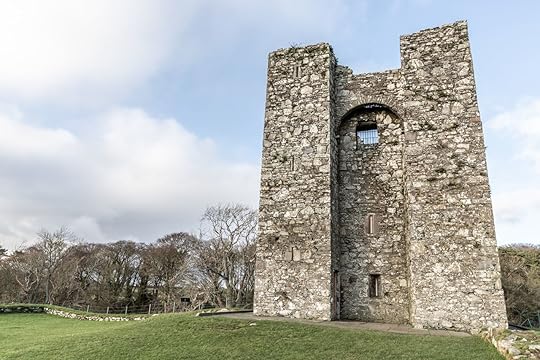
Photo: Lisandro Luis Trarbach/Shutterstock
As the fortification manned by House Frey, the Twins aren’t necessarily anyone’s favorite place in Westeros. Their design was based on Audley Castle, under 10 minutes from Castle Ward. Since there’s only one building at Audley, HBO digitally recreated another one to be the second tower. The field surrounding the castle was used for when Robert Baratheon and his escorts arrive at Winterfell in the first season, as well as for Robb’s camp in the second season, where he met Talisa and where Jaime was imprisoned.
Inch Abbey
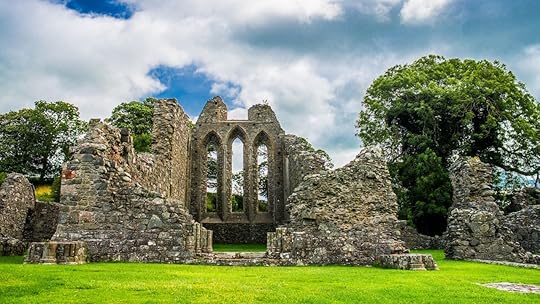
Photo: Lyd Photography/Shutterstock
This location is actually on the way to Castle Ward from Belfast, but we recommend doing it toward the end of your day when you’re on your way back because it’s open 24/7. Inch Abbey was founded by John de Courcy as penance for destroying Erenagh Abbey, and the buildings date back to the 12th and 13th centuries. It was used for Robb’s camp in the Riverlands, and show fans should recognize the ruins of the abbey as the place where Robb was named King in the North. 

More like this: 23 real-life settings you can visit from Game of Thrones
The post The best one-day ‘Game of Thrones’ road trip through Northern Ireland appeared first on Matador Network.

The best Piña Coladas in San Juan
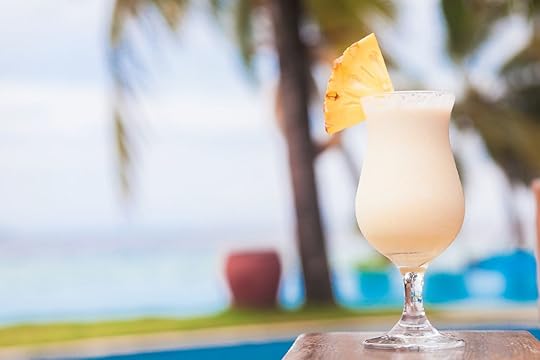
You don’t have to go far to find a Piña Colada in San Juan, Puerto Rico. The cocktail’s birthplace is rife with frosty hurricane glasses full of rum, coconut cream, and pineapple juice. The bar at your hotel undoubtedly blends a reliable version, which you can happily slurp while lounging on the sunny hotel patio until you get brain freeze. But you don’t want to simply call it in when drinking Piña Coladas in Puerto Rico — because the bars on this island make some of the best vacation drinks in America.
To start, any lover of frozen beverages needs to make the pilgrimage to the bar that invented the Piña Colada — or rather, both bars that “invented” it. Narrowing down the options, it gets a little complicated. Barrachina and the Caribe Hilton have tussled for decades over credit for the drink. The Hilton claims that bartender Ramon Marrero created the drink there in 1954 though a competing story gives credit to another bartender there, Ricardo Gracia. Another theory claims that Marrero put together an ersatz version while working at Barrachina before moving to the Caribe Hilton. Or maybe it was yet another bartender at Barrachina, Ramon Portas Mingot, who was first. Lost yet?
Luckily, the long-standing feud doesn’t detract from the delicious beverages at both bars, so in the name of fairness, try both. The bars are just 20 minutes apart by car. But why stop the bar crawl there? A handful of bars around town have put their own spins on the Piña Colada that are worth checking out too. The next time you’re in PR, here are the spots you have to hit.
1. Barrachina
Start your journey round the whirring slushie machine at Barrachina. A neon sign announces the bar in the evening, but pink stone walls that flank the courtyard make it an even more delightful day-drinking spot, when a tall, frosty drink is most appropriate. Pass the time sipping your drink watching the bartender as he fills entire pitchers from a row of drink machines while hoards of tourists gobble them down just as quickly.
2. Caribe Hilton
View this post on InstagramA post shared by Caribe Hilton (@caribehiltonpr) on Jan 12, 2018 at 6:33am PST
Gone is the Beachcomber Bar that once lured drinkers to the hotel, so make your way to Caribar, the now de facto Colada maker on the grounds. Blenders are the preferred tool here, so expect an icier rendition of the classic cocktail that’s a bit easier to drink (and refill and drink again).
3. Bar La Unidad
For another modern take on the drink, head to Bar La Unidad. Bar partner Candido Alfonso describes the bar as a high-end speakeasy, and the team’s riff on the Piña Colada, the Colada Gold, matches that tone. Bartenders combine Bacardi Anejo 4 Year Rum with a house-made spiced syrup, coconut water, pineapple juice, bitters, and, interestingly, fresh lemon juice.
4. Jungle Bird
View this post on InstagramA post shared by Jungle Bird (@junglebirdbar) on Jun 23, 2017 at 1:58pm PDT
As part of Colectivo Icaro, a group of all-star cocktail bars in San Juan, Jungle Bird serves “not tiki, but Taino-tropical drinks.” Tepache, a drink made from fermented pineapple peel and rind, appears all over central America and the Caribbean, but bartenders at Jungle Bird build on the traditional low-ABV beverage to create a new take on the classic Piña Colada. In the Tepache Colada, servers combine tepache with Don Q Oro and coconut cream for a modern cocktail rooted in tradition.
5. La Penúltima
The bartending industry hangout La Penúltima makes a solid rendition of PR’s hometown beverage, Yisell Muxo, director of brand advocacy for Don Q Rum, says. Bartenders from across town come for La Penúltima’s burgers and back patio but also for the elevated Piña Colada. The drink begins with a quick rinse of Amaro Montenegro, followed by Don Q, a house blend of Coco Lopez and high-fat coconut milk, pineapple juice, maraschino liqueur, and a topping of Angostura bitters and cardamom.
6. La Central
View this post on InstagramA post shared by La Central (@lacentral.bar) on Oct 13, 2018 at 3:14pm PDT
The Piña Colada-ish cocktail at La Central doesn’t really have a name; the bartenders simply called it ponche (punch). Foregoing coconut cream, bartenders fat-wash Don Q Cristal white rum with coconut oil. They then combine that with more rum in the form of Ron del Barrilito and more coconut in the form of coconut water, adding in lime juice and pineapple juice as well. After dry shaking to avoid over-dilution, they serve the drink over crushed ice, giving it a beautiful ombre effect with a hefty helping of Peychaud’s bitters on top.
7. Gallo Negro
George Stern, head bartender of The Polynesian tiki bar in New York, doubles as beverage director of Gallo Negro, bringing serious tropical-cocktail muscle to the PR bar. For his Piña Colada, Stern prefers to split his rum base four ways, incorporating white rum, dark rum, blackstrap, and overproof. He combines the spirits with the classic Coco Lopez alongside coconut milk, as well as heavy cream made in house. Pineapple juice and lime juice round out the recipe, putting the total ingredient count at nine — well over the three required for the most basic version. But what truly separates Stern’s version from others around town is his use of an old-fashioned stand-up mixer to flash blend the cocktail. Similar to a milkshake machine, the mixer perfectly aerates, dilutes, and chills the cocktail.
8. La Casita de Rones
View this post on InstagramA post shared by michelle mahana (@pedeegirl) on Feb 23, 2019 at 8:25am PST
A favorite of Sailor Jerry brand ambassador Anthony Bohlinger, the appropriately named La Casita de Rones is unsurprisingly home to a solid Piña Colada. You may be surprised, though, to find the waterfront watering hole serves not one but three versions, from a classic to a hand-shaken version with coconut water and cane syrup to something called a “Sexy Colada” with ginger and a pinch of sea salt to zest up the drink a bit. But perhaps the bar’s greatest selling point is the view. You can get a perfectly balanced Colada served over crushed ice with a side of gentle surf and Caribbean sunshine. If that’s not #vacationgoals, we don’t know what is. 

More like this: How the Margarita took over America — and lost its soul along the way
The post The 8 Piña Coladas you need to try in its hometown: San Juan, Puerto Rico appeared first on Matador Network.

Japan’s Sapporo Snow Festival photos
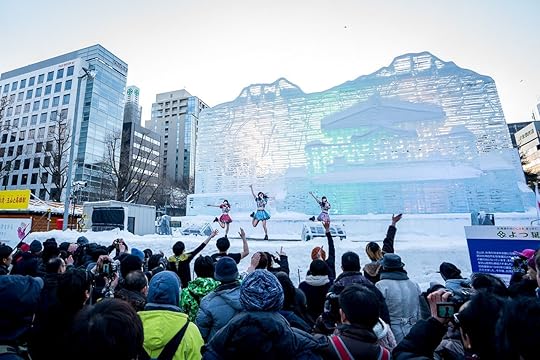
In February of this year, we traveled to Sapporo, in Japan’s northern island of Hokkaido, to see the annual Sapporo Ice Festival. The festival has grown from six sculptures in 1950 to entire city neighborhoods dedicated to ice sculptures and other wintry activities — from ice skating to ski jumping. Every year, teams of designers and ice sculptors come from around the world to fashion their stunning ice creations. 
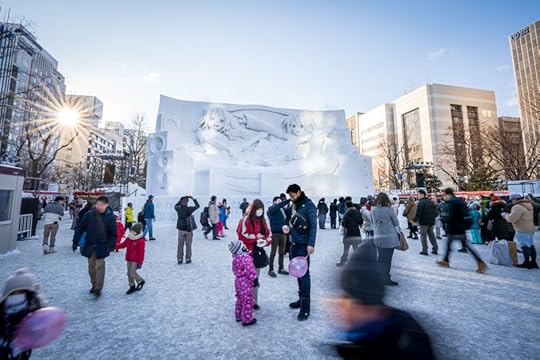
1
Around two million people travel to northern Japan for the Sapporo Snow Festival to see the hundreds of snow and ice sculptures built by both professionals and amateurs. The first festival was held in 1950, and it has grown exponentially since then. We arrive by subway and walk out of the station in Odori Park to the sight of a towering snow sculpture carved to perfection.

2
As we meander through Odori Park, we come across a massive ski slope, an unexpected sight in the middle of a city boasting nearly two million residents. We join a lingering crowd and watch young snowboarders cruise off a jump and down the slope, cheering at the incredible tricks they are able to accomplish while soaring through the air.
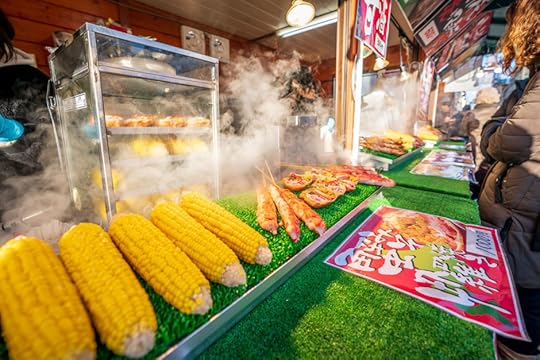
3
The festival isn’t just about snow and ice. Food carts and vendors line the streets, offering tasty food to the many bundled visitors. We buy a few mochis, or small rice cakes, on a stick for something to snack on as we walk around.
Intermission
News
Anonymous person pays for 70 homeless people to stay in hotel rooms to escape the frigid Chicago weather
Eben Diskin
Jan 31, 2019
Culture
Fire, flowers and phalluses: Ten festivals in Japan
Turner Wright
Apr 8, 2010
News
Immerse yourself in Van Gogh’s Starry Night at this Paris exhibit
Eben Diskin
Mar 5, 2019

4
Interactive activities like ice skating give festival-goers a chance to have fun and stay warm in the chilly winter air. The ice skating rink is at the base of the Sapporo TV Tower, which rises above the park at 483 feet. We watch other visitors both succeed and fail while trying their luck on the ice.

5
As the lingering dusk draws nearer, we stop and grab a few hot drinks to keep the cold at bay. Booths lining the walkways offer everything from warmed wine to steaming tea, and though the servings are on the small side, we treasure our tiny bit of cocoa until the last drop.

6
Singers and dancers begin to appear on the many stages as daylight slowly fades. Colorful lights begin to illuminate the sculptures, adding a layer of depth to them and the performances for which they serve as a unique backdrop.
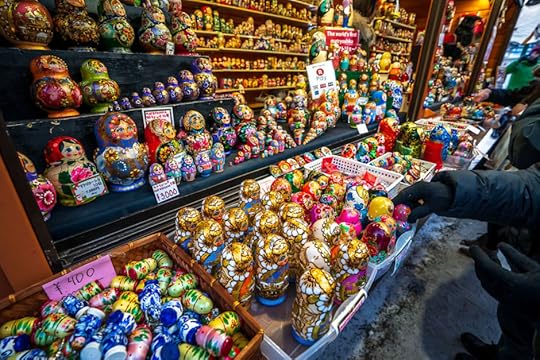
7
Trinkets and souvenirs from around the world fill the small shops that are scattered throughout the park, adding color to the mostly white and gray festival. We wander from vendor to vendor as tourists crowd the shops and make purchases, hoping to bring a little piece of the festival home with them.
Intermission
News
Immerse yourself in Van Gogh’s Starry Night at this Paris exhibit
Eben Diskin
Mar 5, 2019
Travel
Losing my travel virginity: Majime
Turner Wright
May 30, 2009
News
This light installation in Scotland highlights rising sea levels in a way you can’t ignore
Eben Diskin
Mar 7, 2019
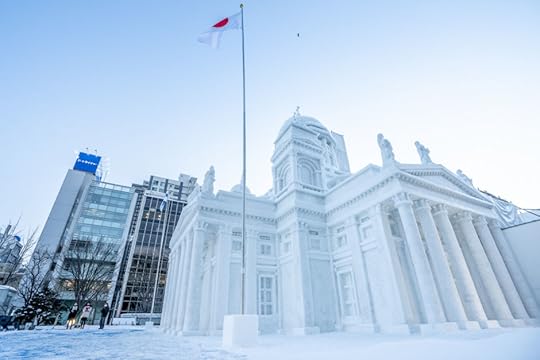
8
We stumble upon one of the most impressive snow sculptures at the festival, a likeness of the Helsinki Cathedral in Finland. A nearby sign details the various steps that nine teams of about 15 people took to building the 52-foot-tall ice creation.

9
The subway system is very easy to understand and is a must for navigating the city. A quick ride gets us to the various locations of the festival, which are strewn about the city. The main sites include Odori Park, Susukino, and Tsudome.
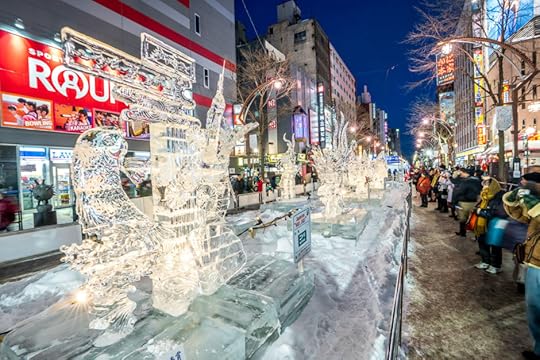
10
Our subway ride takes us to the Susukino Ice World. This area of the festival is home to the incredibly detailed ice sculptures, like this first prize winner. Illuminated at night and surrounded by the bright lights of downtown Sapporo and hundreds of restaurants, the sculptures take on the colors around them.
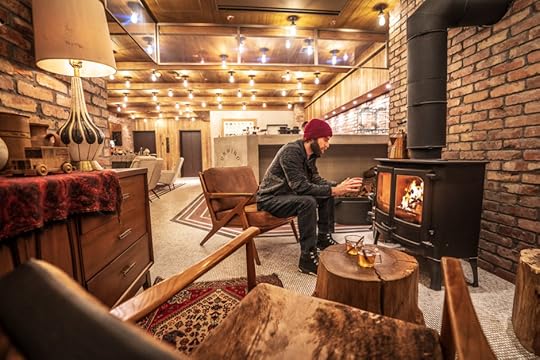
11
After a day of viewing incredible ice sculptures, we head to the Unwind Hotel. Located in the heart of the city, the hotel mimics a cozy ski lodge - perfect for battling the cold winter nights. We sip hot cider and warm up by the lobby’s toasty fireplace.
The post The Sapporo Snow Festival is a feast for the eyes, and you need to see it appeared first on Matador Network.

Matador Network's Blog
- Matador Network's profile
- 6 followers



